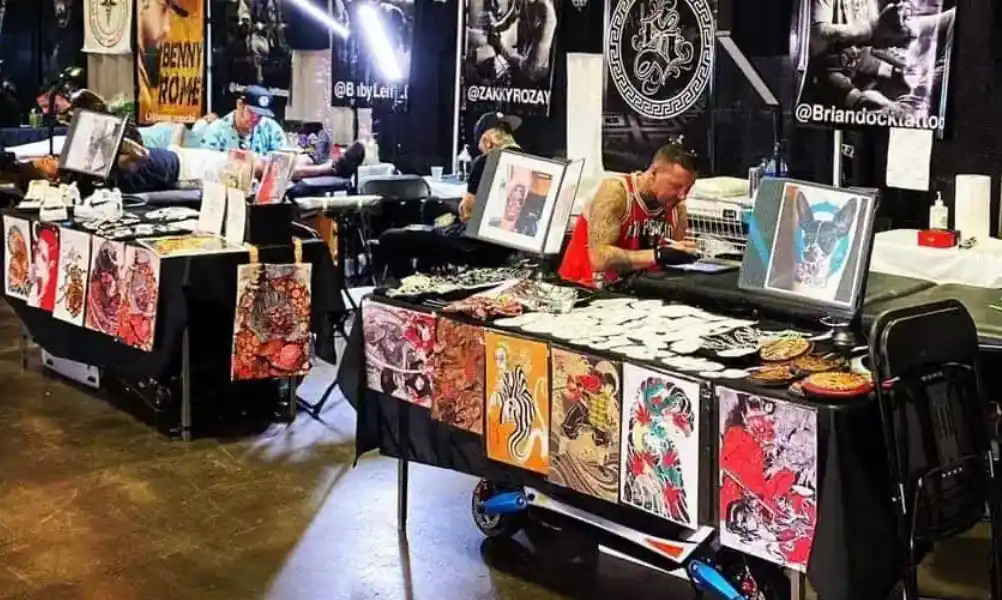Preparing for a tattoo expo involves careful planning of your booth, portfolio, hygiene, and networking strategies. This guide for first-time tattoo artists and brands outlines essential steps to create a professional, visually appealing booth, engage visitors effectively, and maximize business opportunities at your debut expo.
KinInk.co.kr
Taking your first step in tattoo expo preparation requires thoughtful planning and execution. From booth design and portfolio presentation to hygiene and networking strategies, this guide helps first-time tattoo artists and brands confidently showcase their work, engage visitors, and build valuable industry connections on a global stage.
Table of Contents

First-Time Tattoo Expo Checklist for Artists & Brands
“From Booth Setup to Networking: Strategies for a Successful Debut”
Tattoo expos are more than simple exhibitions—they are celebrations of the entire industry. Artists, brands, and consumers converge to explore the latest trends, techniques, and equipment while engaging in meaningful exchanges.
For first-time participants, excitement comes hand-in-hand with preparation. This guide provides a practical checklist for tattoo artists and brands attending their first expo.
Booth Concept & Design – Your Brand’s Face
For Tattoo Artists
- Define Your Booth Concept: Showcase your unique style through color schemes and atmosphere. For example, blackwork artists may opt for minimalist, monochrome designs, while new school artists might embrace vibrant, energetic themes.
- Visual Elements: Include posters, banners, display tables, and proper lighting. Your booth represents you.
- Portfolio Presentation: Use portfolio books, iPad slideshows, or printed samples to highlight your work.
- Merchandise & Business Cards: Stickers, postcards, and cards leave a lasting impression on visitors.
For Brands
- Storytelling-Focused Booths: Convey your brand philosophy visually. For example, an ink brand emphasizing safety and premium quality could use black & gold tones and highlight certification logos.
- Immersive Visual Elements: Include wall graphics, spot/downlights, interactive screens, and portfolio displays.
- Consumer Touchpoints: Business cards, QR codes, and merchandise help reinforce brand identity.
Equipment & Hygiene – Building Trust
Artists
- Backup Equipment: Extra machines and needles for unexpected situations.
- Certified Inks: Use vegan or REACH/FDA-approved inks to emphasize safety.
- Hygiene Kit: Gloves, disinfectants, barrier films, and disposable items are essential.
- Power & Table Setup: Bring multi-plugs, extension cords, and portable lighting for a smooth setup.
Brands
- Product Samples: Display packaged products and provide testable samples.
- Demo Equipment: Machines, power supplies, and consumables for live demos.
- Safety Documentation: Certificates, test reports, and ingredient lists build credibility with buyers.
Customer & Visitor Engagement – Communication Strategies
- Quick Consultation Scripts: Be ready to explain procedures, safety, and pricing within a minute.
- Interactive Experiences: Flash tattoos, mini sessions, and sample distributions increase booth dwell time.
- Limited-Edition Designs: Offer small-scale or flash designs exclusive to the expo for an enhanced visitor experience.
- Live Demonstrations: Short on-site tattoo performances boost attention.
- Brand Experience Zones: Let visitors touch, compare, and test products.
- Encourage Social Sharing: Photo zones and event-specific hashtags (#TattooExpo #KININKExperience).
Networking & Business Opportunities
- Artists → Artists: Exchange styles, propose collaborations, or secure international guest spots.
- Brands → Artists: Demonstrate new products, provide samples, and discuss long-term partnerships.
- Suppliers → Buyers: Negotiate distribution contracts, meet overseas agents, and discuss pricing.
- Preparation: Prepare clear negotiation materials in English (price lists, MOQ, delivery schedules).
- Use Social Media: Share photos/videos on Instagram and TikTok before, during, and after the event.
Practical Expo Checklist
- Booth layout and printed materials finalized.
- Extra equipment, ink, and consumables ready.
- Hygiene kits and disinfectants prepared.
- Portfolios, product brochures, and business cards produced.
- Social media posts and hashtags pre-scheduled.
- Payment options ready (cash, card, QR payments).
- Safety certifications and test reports printed and brought.

Post-Expo Follow-Up – The Experience Continues
“The real value comes after the expo ends”
- Lead Management: Record received business cards and consultation details; prioritize and send follow-up emails.
- Social Media Follow-Up: Post “expo sketches” or product feedback content.
- Performance Analysis: Evaluate promotional ROI, new client acquisition, and partnership opportunities.
Conclusion – The Expo as an Investment & Brand Stage
A first-time expo is not about perfection—it’s a process of learning and growth.
- Artists: Showcase artistry and gain industry recognition.
- Brands: Promote products and philosophy while discovering new opportunities.
- Takeaway: Tattoos are art on the skin, but expos are the bridge connecting artists and brands to the world.
For first-timers, replace nerves with excitement and prepare your stage with this detailed checklist.



